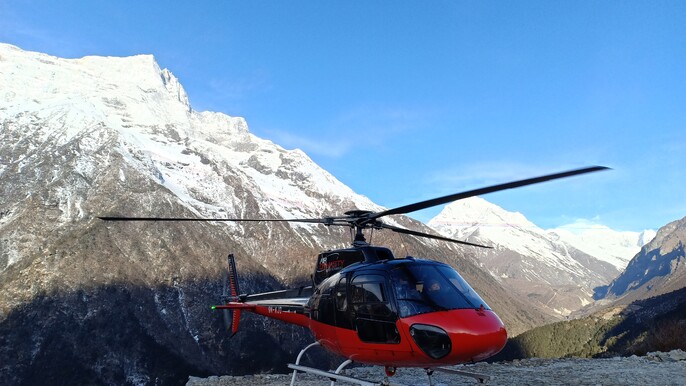March-May & Sept-Nov 2025 - Lobuche Peak (Himalayas) - Guided *CLIMB*

Description
Khumbu - Lobuche East Peak (Himalayas)
What is Nepal popular for? The most probable answer will be tall mountains, peaks, and hills, which is the right answer. Yes, Nepal is known for the land of Mount Everest and seven other eight-thousanders. Not only that, but there are also numerous other peaks that are high enough to touch skies. In very simple words “Nepal is a blessed country with the world’s highest and most beautiful mountains”.
From highest Mt Everest (8,848m) to smallest Gokyo Ri (5,357m), Nepal’s list of mountains is long which includes many technical peaks, easy trekking peaks, and high hiking peaks. Thousands of beginners, semi-professionals, and professional climbers come to Nepal every 12 months to climb one more mountain. The beginners reach here to learn basic mountaineering skills by climbing the trekking peaks. There are several trekking peaks and amongst that the Lobuche Peak is one of the most popular.
Lobuche Peak is a well-known trekking peak of Nepal located in the Khumbu region. Consisting of two faces; Lobuche East (6,119m) and Lobuche West (6,145m), the Lobuche peak lies just above the Lobuche village and Khumbu Glacier. Peaks like Mount Everest and Lhotse lie just 13.5 Km east from the Lobuche Peak. Of two faces, the Lobuche East is an easily climbable peak and thus regarded as the trekking peak. On the other side, Lobuche West is less frequently climbable and more technical and hence listed as the expedition peak. So, Lobuche East (6,119m) is the summit point of Lobuche Peak Climbing, not the Lobuche West.
Lobuche East Peak climbing is the best plan for beginners to tick the very first peak climb of their life. This not too difficult trekking peak offers the beautiful but learnable climbing experience. Climbers summiting Lobuche East can finally move up towards another mountain. Reaching the Lobuche top is not an end of the expedition but the start of many more climbs.
Furthermore, Lobuche Peak Climbing arranges the awestruck mountain views along the way and from the top. Being very near to the Mahalangur section, this expedition gets you the vision of Everest along with Lhotse, Ama Dablam, Pumori, and several others.
Highlights of Lobuche Peak Climbing
- Reach the summit of Lobuche East Peak which stands at 6,119m.
- Eyeshot the breathtaking Himalayan panorama from the top.
- Get overly satisfied by heavenly views of Mt Everest, Mt Lhotse, Mt Makalu, Mt Nuptse, Mt Amadablam, Mt Pumori, and several more peaks.
- Pass just by the world’s highest glacier, Khumbu Glacier
- Do trek over the trail of the most popular Everest Base Camp Trek until Lobuche.
- Explore the uniquely established Sherpa settlements and their culture.
- Trek amid prayer flags, gompas, monasteries, via suspension bridges, and through dense woods.
Lobuche Peak Climbing Route
The journey starts with a flight to Lukla from Kathmandu and then trek through villages like Phakding, Namche, Tengboche, Dingboche, and finally Lobuche. From Lobuche, the routes get separated where the EBC route heads towards Gorakshep, and Lobuche Peak’s path moves to Lobuche Base Camp. Everest Base Camp is just 8.5km southwest from the Lobuche village, that is why Everest Base Camp Trek is added too often in most of the Lobuche Peak itineraries.
Thereafter, Lobuche Peak climbing trail approaches the Lobuche Base Camp which resides at an altitude of 4,950m. After the Base Camp, the route heads upward just over the Khumbu Glacier to reach Lobuche High Camp (5,400m). The nights after Lobuche village have to be spent in the tented camps.
Lobuche Peak summit is only one hard stretch away from the high camp. The path turns steeper and steeper after the high camp where the summit track finds its way through a sharp snow ridge. Then, the route turns towards the north-west of the peak where some snow bumps and notches lie. After that is the final summit climb over a steep part towards the summit point.
How difficult is Lobuche Peak Climbing?
Lobuche Peak is one of those trekking peaks of Nepal which is slightly more difficult than other similar peaks. This expedition involves steep and high-altitude trekking and hard climb. Before you start Lobuche Peak climbing, you have to trek all the way from Lukla to Lobuche Base Camp. For that part of trekking, you will require an average of 5 to 6 hours of trekking per day. The hiking trails are not plain but steep and tiring. Beginners who have not trekked before can face some problems while trekking days. The trek is around the higher parts of the Khumbu region so a foreigner can struggle with altitude sickness.
Once you cross Lobuche village, the trail starts to get rough, steady, and rocky. Some nights until return to the village are meant to be spent in the camp tent and have to eat food cooked by the helper there. This can be a little difficult situation for those who have not climbed a mountain before. The rough trails get steeper and steeper as you head towards Lobuche’s Base Camp. Sometimes while ascending, you need to use mountaineering gears like rope, ice axe to move ahead. Then comes the summit day on which you have to climb the Lobuche East and head back to the base camp. A total of around 8 to 10 hours will be required to do so on the summit day.
Summit climbing is also not easy as said. There is a steep and snowy section just a few climbs below the summit which is sloped in around 45°. This particular part is as lengthy as 50m, and it can be more difficult than other sections. Beginners face more problems at this part of Lobuche Peak climbing, and they have to give a real test of their skills. Other than these facts written above, the Lobuche Peak is a doable trekking peak; however, having prior mountaineering training, practice, and knowledge is essential.
Included
Two-nights deluxe accommodation in Kathmandu B&B.
Arrival and Departure private transfers.
Flights Kathmandu - Lukla - Kathmandu.
Special climbing peak permit.
Professional guide (Sherpa) shared amongst two climbers.
Everest National Park - Permits.
All meals whilst trekking/climbing including tea/coffee (seasonal fruits).
Accommodation whilst on trek/climb = mountain lodges & tents.
Porters (15 to 18 kg max).
Climbing t-shirt, certificate and Route Map.
Down (-20) sleeping bag, and jacket (returned on completion).
Medical kit, normal medical supplies.
Excluded
- Travel Insurance with Medical Evacuation (compulsory) + Oxygen (if required).
- Monies for upfront helicopter evacuation.
- Alcoholic beverages, laundry and tips.
- Climbing Equipment other than specified in the inclusion section.
Know before you go
- Trekking / Hiking Boots.
- Camp Shoes / Sandle.
- Trekking or duffle bag to carry trekking gear.
- Trekking Day-pack for personal Carrying Materials.
- Pair of Trousers / Water Proof Gaiters.
- 1 Sleeping Bag.
- 1 Down Jacket.
- 1 Light – water and wind proof Jacket.
- 1 Water bottle.
- Tourch Light / Flash light and spare batteries.
- pairs of long sleeve cotton shirts.
- 1 Medium size towel.
- 1 Fleece / warm sweater.
- Pairs of t-shirts.
- Pairs of light and warm socks.
- 1 Warm Hat.
- 1 Sun Hat.
- Sun – Glasses.
- Trekking Poles.
- Personal toiletries – Soap / Shampoo / toilet paper etc.
- Pills or tools for water disinfection.
- Sun block lotion for lips and body parts and a handkerchief or wiping papers.
- Money belt and some first-aid kit.







